Archive for August, 2021
Pay-as-you-go rego back on the table
The controversial topic of car registration is back on the table again, and the notion of a pay-as-you-go system is back in the spotlight as the Victorian Government reportedly leads the assessment of the proposal. Amid the impact of COVID, which has seen many of us not use our cars at all, the issue has gathered extra attention, and it could even bring the topic to a head sooner than otherwise might have been the case.
Central to the discussion has been a recommendation from Infrastructure Victoria, which has proposed car rego fees be abolished in favour of a ‘user pays’ system. Although they have set an extended timeline for this, advising it happen within the next 10 years, that may actually be earlier than other bodies have advocated.
In voicing its support for the proposal, Infrastructure Victoria, which is an independent state government advisory body, argues that the transition to a pay-per-use system would discourage unnecessary driving and promote the uptake of public transport and the like. It believes the current car registration system effectively gives motorists a reason to use their vehicles frequently. Furthermore, the authoritative body suggests that a fixed-price rego does “not reflect the relative costs of providing road infrastructure, the costs of congestion, air and noise pollution, carbon emissions, and road trauma”.

Changes could be much broader
However, it isn’t just a pay-per-kilometre system that is under review. Infrastructure Victoria is also suggesting that drivers entering the inner city be slugged with a congestion charge. The target here is quote clear, insofar as trying to decrease vehicle use. In turn, that would alleviate traffic on our roads, while also doing more for the environment, residents, as well as ensuring a more ‘efficient’ commute.
Motorists could also be faced with the prospect of paying fees depending on the type of vehicle they drive. That is, cars with a greater impact on our roads and the environment could pay more than those with a more modest impact when it comes to noise and air pollution. Electric vehicles would be one of the beneficiaries under such a proposal, while large trucks would obviously carry the burden. In some weighs, our current system already seeks to address this point, albeit the independent state government advisory body believes there may be more room to fine-tune this.
It may even seem all well and good as far as intentions go, but then again, electric vehicle owners have recently been stung with their own separate pay-per-kilometre levy as of the start of July, in addition to their registration fees, which is sure to raise eyebrows given Infrastructure Victoria is pushing for the sale of new petrol and diesel cars to be banned by 2030.
Alfa Romeo and Stellantis

There is change in the air for Alfa Romeo. At the beginning of 2021, a multinational automotive manufacturing corporation called Stellantis was formed on the basis of a 50-50 cross-border merger between the Italian/American conglomerate Fiat Chrysler Automobiles and the French PSA Group. The headquarters of Stellantis is in Amsterdam, Netherlands. Alfa Romeo will be among the first of the 14 brands of Stellantis vehicles that will take a full-electric approach to its new cars. Mentioned at a meeting recently, the new Stellantis group will see Alfa Romeo become a fully electric brand that will compete globally as early as 2027 – its key markets being that of China, Europe and the US.
It is possible that the first all-electric Alfa Romeo could be an electric subcompact crossover that will arrive 2023/24 and combine with similar models from Fiat and Jeep. Stellantis has announced plans to introduce four electric platforms that will eventually cover most vehicles across the company’s 14 brands, and the models should have a power range of 300 – 500 miles (480 – 800 km). Alfa Romeo will use a platform known as the STLA Large, which will also be used by Maserati. There will also be platforms known as STLA Small and STLA Medium. Stellantis says that Alfa Romeo will pursue two battery chemistries for its vehicles. Right-hand drive development was also to be assured, so all future EV Alfa Romeo models could easily be driven in Australia.
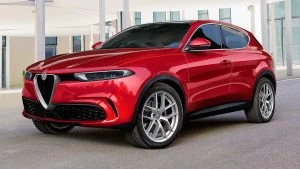
Alfa Romeo Tonale
Next year we should see Alfa Romeo offering its first plug-in hybrid, which will be exciting. I’m a big fan of hybrid technology. The model will most likely be a compact crossover based on the recent Tonale concept.
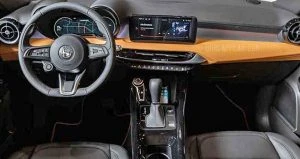
Alfa Romeo Tonale
Until the arrival of the Alfa Romeo Tonale, Alfa Romeo Australia will still enjoy the fantastic-to-drive Alfa Romeo Giulia sedan and Alfa Romeo Stelvio mid-size SUV. For 2021, the Stelvio SUV and Giulia sedan boast some more new technology inside the cars, which includes Level Two advanced driver assistance systems such as traffic sign recognition, intelligent speed control, active blind-spot assist and driver attention assist.
Currently, the entry level Stelvio puts out 148 kW of power and 330 Nm of torque from the 2.0-litre turbocharged petrol engine. You should be able to buy a new one of these for around the $65k mark.
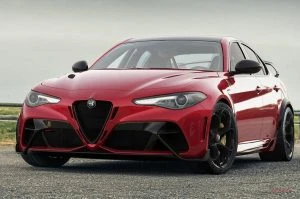
Alfa Romeo Giulia
Fiat Happenings

Scattered around Australia are numerous Fiat outlets with showroom teams that are willing to buy, sell and service any of their special brand of car. You’ll find a Fiat showroom in Perth, Adelaide, Melbourne, Canberra, Sydney, Wollongong, Brisbane and on the Sunshine Coast. There are even more places around Australia who are experts in servicing or accessing parts for your Fiat or Fiat Abarth vehicles. This leaves you very little need to hold off being the proud owner of a new or used Italian legend should you so desire.
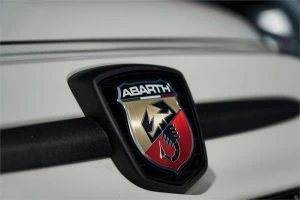
New 2021/2022 Fiat vehicles offer a variety of small 4- and 5-seater cars that come as standard little hatchbacks or hatchbacks with a bit more Abarth pep and performance. The Abarth brand are the performance models that are special Fiat 500s with lots of fun and plenty of zip to make your drive both entertaining and unique. The standard Fiat 500 is a surprisingly roomy small car that is comfortable and efficient to drive.
Fiat also does a range of commercial vehicles that are mainly a variety of medium and large vans. These are popular vans for businesses because Fiat offer their range of modern, safe vans at a reasonable price, and the team are willing to back their vans up with a competitive servicing and warranty package for any of their new Fiat-commercial-model buyers. Fiat also offer the Ducato in a range of motorhome and camper styles.
Fiat really is a quintessential “Made in Italy” stamp with all its Italian history, style, constant innovation and decent quality being part of the modern range. The recent Fiat 500 has seen 80% of its sales outside of Italy, and it is a model that leads the city car segment in Europe together with its cute little sibling, the Fiat Panda.
Recently, the introduction of the Hybrid Fiat 500 and Panda has given an extra boost to the sales of both models. These are exceptionally economical cars. In Italy, the stylish Fiat 500X has been refreshed, ready to continue playing a leading role in many Italian family’s lives. Indeed, since its launch in 2014, the Fiat 500X has always led its segment in Italy, and the car regularly features in the European top 10 small-car segment.
Recent news from Fiat in Europe has seen some other new model launches, which would also be nice to see become available here in Australia – particularly for those of us who want to get the benefits of driving a small and efficient car with Italian style. The final months of last year saw the new Fiat 500, Tipo, Tipo Cross and Panda range, and so Fiat has brought 2021 around with the entire line-up of cars being completely refreshed.
A lot of effort has gone into providing new Fiats and Abarths with all the latest technology, safety, comfort and style for each new variant. New models also boast Euro 6D-Final-compliant engines across the entire range. The Connect trim level is directed at customers who want to stay connected at all times. Models with Connect come standard with the 7-inch Uconnect infotainment system with DAB radio, Apple CarPlay and Android Auto, the easy and efficient way to exploit the services of your device while travelling in your car.
Standard features of the 2021 Fiat 500 also includes cruise control, a sports steering wheel with built-in controls, 15-inch alloy wheels and fog lights. You can also select the dedicated new Perbene Grey/Vesuvius Black two-tone insignia. The 2021/2022 Fiat 500X comes with black seats, a techno-leather steering wheel, 16-inch alloy wheels, blacked-out windows, fog lights, LED DRLs, parking sensors, along with dusk sensors and rain sensors.
Here is a picture of the stunning little Abarth F595. Check out the gorgeous body kit and quad exhausts!
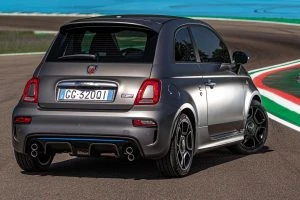
Abarth F595
New EV SUVs
We still seem to be desiring the SUV over other shapes and styles of car. This is for reasons that I can understand; things like safety, space and ride comfort tend to be found in spades when you travel inside a decent-size SUV. Because we are likely to go through a period of history where the EV may well rule the road, are there any SUV-type EVs available now? EVs aren’t selling like hot cakes just yet, but there some EV SUVs bigger than a pint-sized Honda E that you might be interested in. It turns out that, actually, there are some pretty decent EV SUVs available to the buyer loaded with cash. As yet, they aren’t the cheapest vehicles on the planet, particularly if they are of the premium luxury brands, but it’s nice to know that if you did have the money, and wanted a spacious and desirable luxury model, they are already being sold out on the market.
Tesla has the jump on its competition, and they already have a decent wodge of EV clients under their wings. Because it was pretty much the first EV manufacturer to design and build a decent EV, it was Tesla who soaked up the early adopters of Tesla’s EV technology, and it was these buyers who were very keen to align and embrace the new EV technology early on. What is happening now, is that because other manufacturers are only now getting fully into the swing of EV technology, the keenest buyers have already been wooed and taken by Tesla, so, for instance, if you are an Audi e-tron or Jaguar I-Pace, you have a slightly harder job of getting your buyers because you have to actually entice them away from their luxury ICE vehicles and into one of their EV variants.
Tesla Model X
Let’s first give credit where credit is due, and let’s talk about the Tesla Model X EV SUV. The Model X can come with an optional six seats, the middle row boasting full-on Captain’s chairs. The five-seat Model X is the standard guise. I love the falcon-wing doors; they look so cool and make life very easy getting in and out of the car – even in tight parking spaces with as little as 11-inches on either side. Tesla’s Model X cabin is nice, big, and comfortable. Up the front, there is a big infotainment display screen on the dash. This is as big and as good as it gets in any car. The roof/ceiling is also a huge display screen, which is tinted so that the glare from the sun is minimised. The Tesla feels extremely modern but also, at the same time, quite a simple car that is fun to live with. It has funny features like a Fart Mode, which is an emissions testing mode that allows the car to perform fart sequencing and farting whenever it requires to do so. People outside don’t escape the sounds either. This feature does leave one in hysterics – you have been warned! The Tesla Model X is very different to anything else on the road, and that makes it a unique drive. Out on the road, the Tesla Model X is quick, and its ride does a pretty good job of soaking up the bumps. There are better handling cars like the Audi e-tron and Jaguar I-Pace, however.
- Twin electric motors
- 100kWh battery
- Weight: 2459 kg
- Range: Claimed at over 500 km, real world driving more likely to be around 300 km.
- 310 kW of power
- 660 Nm of torque
- Top speed: 250 km/h
- 0-100 km/h: 4.9 seconds
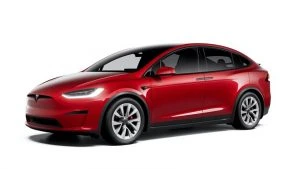
Tesla Model X
Audi e-tron
Audi’s new e-tron has five seats, all rather comfortable and impeccably crafted. The touchscreen system is classy, right up-to-date, and detailed. You do have plenty of menus to work through before finally getting to where you want to be in the infotainment set-up. On the road, the Audi e-tron is exceptionally well-sorted. It feels really tight around the corners, smooth and very quiet. Though EVs are generally heavy vehicles, the e-tron disguises its mass very well, indeed. There is plenty of well thought-out storage compartments throughout the cabin, and on a day-to-day basis this is a nice EV SUV to live with.
- Twin electric motors
- 95kWh battery
- Weight: 2490 kg
- Range: Claimed at around 385 km, real world driving more likely to be around 300 km.
- 300 kW of power
- 664 Nm of torque
- Top speed: 200 km/h
- 0-100 km/h: 5.7 seconds

Audi e-tron
Volvo XC40
Volvo’s XC40 Pure Electric Hybrid is a smaller luxury EV SUV. Safety features include autonomous emergency braking, run-off-road assist and up to Level 2 self-driving in heavy traffic situations. It’s available with AWD and uses a nice silent, smooth electric set-up. The Volvo’s version of an EV SUV is a gem. The XC40 looks and feels very modern, and the XC40’s cabin is impressively spacious. Standard equipment levels are high and include a 12.3-inch digital instrument panel with configurable EV-specific displays, panoramic sunroof, heated front power seats, and inductive charging for your smartphone. Also standard, is the full suite of Volvo safety features, including lane keep assist, blind-spot and cross-traffic alert, and rear collision alert. The 460 litres of boot space opens up to 1336 litres with the rear seats folded down flat. These can be bought new for around $85k, making this a well-priced premium luxury EV SUV that is comfortable and swift.
- Twin electric motors
- 78kWh battery
- Weight: 2158 kg
- Range: Claimed at around 418 km, real world driving more likely to be around 300/350 km.
- 300 kW of power
- 659 Nm of torque
- Top speed: 180 km/h
- 0-100 km/h: 4.7 seconds
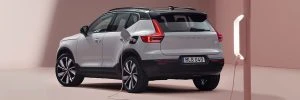
Volvo XC40 Recharge Electric
Jaguar I-Pace
In my opinion, the Jaguar I-Pace wins the EV SUV beauty contest. From every angle it looks nice, athletic, and the perfect blend of old and new design. Even with its GT lines there is a nice amount of space inside the EV Jag. To drive, the Jaguar I-Pace is wonderful. It feels very crisp through the corners and it even has a satisfying growl that flows through the speaker system as you plant your right foot and accelerate hard. Compared with its rivals, the new Jaguar I-Pace weighs in at a comparatively light 2.0 tonnes. This is a lovely EV SUV and is probably the one I’d prefer most of all the snobbish EV SUVs currently on sale.
- Twin electric motors
- 90kWh battery
- Weight: 2068 kg
- Range: Claimed at around 420 km, real world driving more likely to be around 300 km.
- 294 kW of power
- 695 Nm of torque
- Top speed: 200 km/h
- 0-100 km/h: 4.5 seconds
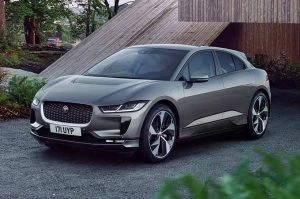
Jaguar I-Pace
BMW’s latest iX and Mercedes Benz’s EQC are some other luxury EV SUVs worth a look at. And then some other considerations that are substantially cheaper than the premium EV SUVs mentioned above would be the small Mercedes-Benz EQA and the very good MG ZS EV, Hyundai Kona and Kia Niro.
Some big reasons why you’d want to change to a EV SUV right now would be the driving smoothness, the driving silence, self-driving safety features, and the potential for saving money at the “pump”. I think it was Top Gear who recently suggested that, on average, the running costs of one of these were on a par with an equivalent petrol car capable of 73 mpg (3.2 litres/100 km). That’s if you were to do most of your charging at home and not at public charging stations.